Francis F. Palmer House
| Francis F. Palmer House (aka George F. Baker Jr. House) | |
|---|---|
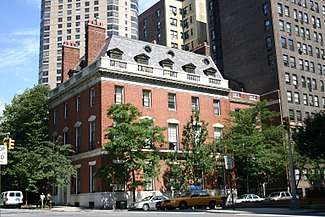 (2010) | |
| Official name: Synod of Bishops of the Russian Orthodox Church Outside of Russia | |
| Designated | January 14, 1969 |
| Location | 75 East 93rd St, Manhattan, New York City |
| Coordinates | 40°47′6.25″N 73°57′15.79″W / 40.7850694°N 73.9543861°W |
| Built | 1917–1918; North Wing 1928; Ballroom 1928 |
| Architects | Delano & Aldrich |
| Architectural style | Neo-Georgian |
The Francis F. Palmer House (also known as the George F. Baker Jr. House) is a mansion located at 75 East 93rd Street in New York City, designed by the architects Delano & Aldrich and constructed for Francis F. Palmer in 1918. The financier George F. Baker, Jr. purchased the house in May 1926, and in October 1927 added No. 69 East 93rd St. to his holdings.[1] Baker engaged Delano & Aldrich to design several additions: an annex on Park Avenue; a ballroom wing; a house for staff at No. 69 (completed in 1929); and a separate townhouse at No. 67 (completed in 1931). The placement of the original house, the ballroom and the staff quarters form a small courtyard facing East 93rd Street.
Earlier, in July 1919, Baker and his wife, Edith Kane Baker, bought another house, the Henry Brevoort Mansion on lower Fifth Avenue. (Edith Baker was Brevoort's great-granddaughter.) [2] The couple intended to renovate the house for their own use but sold it in 1925. Before they did, they removed two mantels and an ornamental plaster frieze, all of which were installed by their architects in their new living room on 93rd Street.[3]
George F. Baker, Jr. added a townhouse to the complex at 67 East 93rd Street, also designed by Delano & Aldrich, to be used as a residence for Baker's father, George F. Baker, Sr. The house was completed in October 1931, [4] but the father died at his Madison Avenue home before he could move into the new house. [5]
75 East 93rd Street
In 1958, Edith Baker sold the Main House, the Annex and the Ballroom wing. (Before doing so, she donated two antique chandeliers from the ballroom, each with about eighty rock crystal prisms, for use in the White House.) The house's new owners, the Russian Orthodox Church Outside of Russia, converted the Annex to a school, converted the Main House to administrative offices of the church's Synod of Bishops, and converted the Ballroom to the Synodal Cathedral, adding an exterior staircase down to the courtyard and through a new gate to 93rd Street. [6]
After a public hearing on November 10, 1966, the Landmarks Preservation Commission voted on January 14, 1969 to designate 75 East 93rd Street a landmark, declaring it to be "an outstanding example of a modified Federal style...one of the finest works in New York City, by the architects, Delano and Aldrich." In 1997, following approval of the Landmarks Preservation Commission, the architect Michael Dwyer restored the building's windows and replaced the slate roof.
69 East 93rd Street
After a public hearing on November 10, 1966, the Landmarks Preservation Commission voted on January 14, 1969 to designate 69 East 93rd Street a landmark, declaring it to be "an outstanding example of a modified Federal style...dignified in character...spacious in conception." On June 28, 1989, the financier, preservationist and author Richard Jenrette bought No. 69 from George F. Baker IV (George and Edith Baker's grandson).[7] In 1997, Jenrette sold the house to the Classical American Homes Preservation Trust, which used it as its headquarters.[8]
67 East 93rd Street
After a public hearing on June 25, 1974, the Landmarks Preservation Commission voted on July 23, 1974 to designate 67 East 93rd Street a landmark, declaring it to be "a handsome residence designed in a modified version of the neo-Federal style." In 1977, the estate of Edith Baker sold the house to Edward F. "Eddie" Ulmann,[9] chairman of Allied International, a manufacturer of aerospace products, and a one-time amateur national racquets champion.
In 1987, Ulmann sold the house to Richard Jenrette,[10] and in 1989 Jenrette sold it to the art dealer Stephen Mazoh.[11] During his tenure, Mazoh operated an art gallery in the house, acting as agent in 1993 for the sale of Vincent Van Gogh's Wheatfield with Cypresses, sold to Walter H. Annenberg for $57 million — at the time the 6th most expensive painting ever sold.
In 1996, Jenrette bought the house back from Mazoh,[12] and used it as his New York residence until his death in April 2018.
Gallery
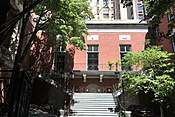 Ballroom Wing at 75 East 93rd Street
Ballroom Wing at 75 East 93rd Street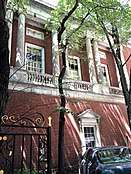 The Colonnade at 69 East 93rd Street, overlooking the Courtyard.
The Colonnade at 69 East 93rd Street, overlooking the Courtyard.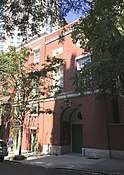 The Facades of 67 & 69 East 93rd Street, New York City
The Facades of 67 & 69 East 93rd Street, New York City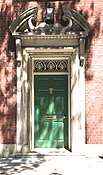 The Entrance at 67 East 93rd Street.
The Entrance at 67 East 93rd Street.
Further reading
References
- ↑ The New York Times, October 22, 1927, page 30.
- ↑ The New York Times, July 13, 1919, page 83.
- ↑ Daily News, November 4, 1990, page 177.
- ↑ New York Department of Buildings, Certificate of Occupancy 17950, October 29, 1931.
- ↑ The New York Times, May 3, 1931.
- ↑ New York Department of Buildings, Certificate of Occupancy No. 51272, October 1959.
- ↑ Deed of Sale, June 28, 1989.
- ↑ Deed of Sale, December 3, 1997.
- ↑ Deed of Sale, November 7, 1977.
- ↑ Deed of Sale, December 9, 1987.
- ↑ Deed of Sale, June 29, 1989.
- ↑ Deed of Sale, April 18, 1996.